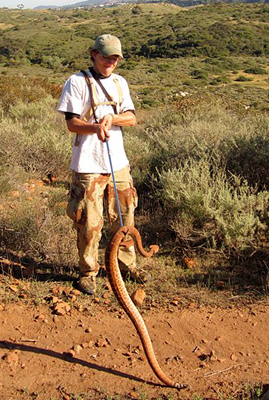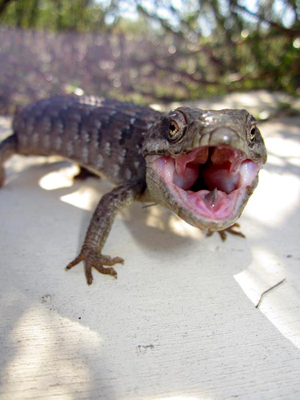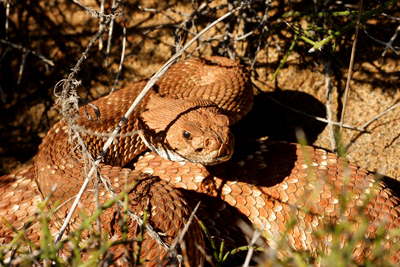Field Herpetology

By Filip Tkaczyk
"Field herpetology" is the study of reptiles and amphibians in their natural setting. The abbreviated description for reptiles and amphibians is "herps" from which also comes the term "field herping" or the practice of seeking reptiles and amphibians in the field either professionally or as a hobby.
Ethics of Field Herpetology
Because of their sensitive nature and continued loss of habitat to development, logging and other destructive practices, it is vital to practice good ethics while seeking herps in the field. First, minimize your general impact to a place. This includes minimizing disturbance to habitats and microhabitats by not damaging plants, cover objects and sheltered spots. If cover objects are flipped, they should be placed back exactly as they were so as to minimize loss of the microclimate underneath, especially moisture.
Second, do not handle reptiles and amphibians unnecessarily. Respect your local laws. In some states handling of all herps is prohibited. Never harm any herps and avoid situations that could cause harm. If you do handle any herps, place them back exactly where you found them.
Third, do not release captive animals into the wild or long-held wild caught animals back into the wild. There is a high likelihood of these animals dying in the wild. Also, captive animals have caused the extinction of local populations of some amphibians and reptiles in the wild because of the introduction of diseases due to their release into the wild.

Fourth, respect other people and their needs. This includes, respecting private property
and not trespassing. Teach people about
herps when you encounter them in the field and they seem interested. Do not disturb research sites and associated
materials. Be careful about sharing information about field herpetology
locations, particularly abundant and diverse locations, as sometimes poachers
may use this information to illegally collect as many specimens as they can.
Be More Prepared For Your Next Outdoor Adventure!

Don't leave home without knowing these six essential survival skills. Our free survival mini guide reveals the strategies of:
- Shelter & fire to prevent the number one cause of death
- Obtaining clean water to avoid life-threatening dehydration
- Common wild survival foods and other critical skills!

Observation Techniques for Field Herpetology
There are several different approaches to observing herps in the field. The most basic is that of moving around a likely habitat and looking closely for their presence on surface objects such as logs, rocks, branches, at the water's edge or floating on its surface. This by itself can be challenging, as many herp species have patterns and behaviors that allow them to blend in perfectly into their surroundings. A slow, patient approach is required.
Some herps, however, require you to take a more active approach and require you to lift cover objects in their habitats. This is especially true of shy, moisture-loving species such as salamanders. Other species are only active at night, and so must be sought with the aid of a light at night. Some species, especially, snakes, are often found basking on roads on warm evenings.

Amateur and professional practitioners of field herpetology use the technique of setting out cover objects in promising habitats. Wide, flat boards or pieces of tin are used in sunny or partially shaded spots to attract certain herps, especially snakes. These must be left undisturbed for at least several months (best for at least a year), in order to form the proper microclimate features to attract herps. When these cover objects are set out in a formation, they are called a "board line" and have been used successfully as survey techniques to assess the presence and relative abundance of various herp species.
Lastly, an additional technique that is useful to naturalists in general, and also to those who enjoy field herping, is the art and practice of wildlife tracking. Tracking means using your skills of observation to watch for those signs in the landscape which indicate the presence of herps. This includes: tracks, scats, shed skins, eggs, digs, and other kinds of sign. Locating these signs can often lead to finding the animal itself, as many species live within a relatively small area.
Happy herping!
By the way, when you're spending more time in nature it's important to know how to stay safe in the outdoors, especially if you were to get lost. Right now you can get a free copy of our mini survival guide here, where you'll discover six key strategies for outdoor emergencies, plus often-overlooked survival tips.
Further Resources:
Learn to ID herp sign with the Tracks & Sign of Reptiles & Amphibians book.
Take your skills further with our Wildlife Tracking Courses.
Learn more about field herpetology on the Burke Museum website.

About the Author: Filip Tkaczyk is a periodic guest teacher at Alderleaf. He also wrote the field guide Tracks & Sign of Reptiles & Amphibians. Learn more about Filip Tkaczyk.
Return from Field Herpetology back to Wildlife Tracking Articles
Is The Essential Wilderness Survival Skills Course Right for You? Take the "Online Survival Training Readiness" Quiz
See for yourself if this eye-opening course is a good fit for you. It takes just a few minutes! Get your Survival Training Readiness Score Now!

Grow Your Outdoor Skills! Get monthly updates on new wilderness skills, upcoming courses, and special opportunities. Join the free Alderleaf eNews and as a welcome gift you'll get a copy of our Mini Survival Guide.

 The Six Keys to Survival: Get a free copy of our survival mini-guide and monthly tips!
The Six Keys to Survival: Get a free copy of our survival mini-guide and monthly tips!
Learn more